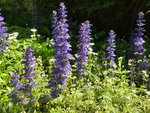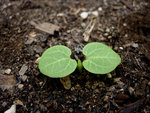

It saddens me to see people spending money on little vegetable plants in unrecyclable plastic containers -- because most vegetables are so easy to grow from seeds. Yet the trend away from seeds and towards potted plants must have gained steam in the past few years. Last week the nursery was overflowing with 10-inch high corn starts, potted root vegetables like carrots and beets, and young bean plants already looking for a pole to climb.
What you really buy when you purchase plants rather than seeds is time. But most plants will suffer quite a setback from the trauma of being transplanted, thus reducing the value of your investment to a couple of weeks. And really, what’s the hurry?
One of the great rewards of gardening is planting seeds and watching them come up. Granted, it is an act of faith to believe that a little packet of seeds could actually transform into carrots or cucumbers. But that’s the point: gardening makes us partners with miracles. And people who rely solely on started plants rather than planting seeds miss this best miracle of all.
Of course there are exceptions: tomato, peppers and eggplant need a head start to mature in our climate, so it makes sense to buy started plants of those, unless, of course you have a greenhouse or cold frame. It’s also justifiable to buy plants if you only want one zucchini plant – and heaven knows one is generally more than enough unless you live with 10 roommates.
Still, no matter how many years I’ve planted them, it is still a thrill to watch beans rise from the ground and open their seedling leaves.
The experimental, the unexpected and the spontaneous
Years ago, a woman who had recently immigrated from Vietnam was horrified by how much space in my garden is devoted to flowers. “You should be growing more food!” she exclaimed in shock. She scolded me at some length over what she regarded as wasteful extravagance.
I’ve known for a very long time that by global standards, I am quite wealthy, and I felt a deep sympathy for the life that led her to think that way about flowers. But paradoxically, her scolding only deepened my appreciation for the good fortune of being able to grow them.
Right now I’m enjoying an experimental planting where sweet woodruff and a deep purple-blue ajuga are cohabiting. I planted them together knowing that both are aggressive growers, but hoping one would not overwhelm the other. So far, they’ve been good companions, actually sharing space. The ajuga spires rise above a mass of tiny white woodruff flowers. At the moment, I’m quite pleased with myself.
Not all of my experiments have turned out so well though, and a few years from now, my cohabitants may yet go to war with one another. C’est la vie.
All gardens are constantly evolving. Sometimes the evolution is the work of the gardener; sometimes it’s serendipity. The seeds of a plant grown by a neighbor two blocks away may land and germinate in your garden, and you may reap an unearned benefit. I have two varieties of oxalis and some bleeding hearts that just showed up in the last two or three years. I think the bleeding hearts moved in from next door; I have no idea where the oxalis came from. Miraculously, they all landed in just the spots where I’d have planted them.
The essential lesson here is to avoid being overly controlling and to make room for the experimental, the unexpected, and the spontaneous. Like remembering to be grateful for the good fortune of having a bit of land to plant, this is another lesson that has value beyond the garden.
Jill Severn writes from her home in Olympia, where she grows vegetables, flowers and a small flock of chickens. She loves conversation among gardeners. Start one by emailing her at jill@theJOLTnews.com
1 comment on this item Please log in to comment by clicking here
joycetogden
I'm another "old farmer" senior who just got back from the garden store with 2 packets of seeds-- mixed lettuce and nasturtium. All I can grow that doesn't attract slugs or deer is on the deck planters well above everything.
Saturday, May 8, 2021 Report this